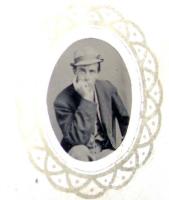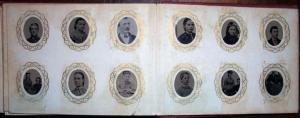
This Cambridge photograph album is dated 1867 and contains 205 gem tintypes, many with hand coloring. The word “Cambridge” on the title page does not refer to the photographs inside but was simply the album brand sold by Remick and Rice, the major producers of gem tintype albums. The album measures 3 1/2 x 3 1/4 inches; with each photo opening measuring 7/8 of an inch high by 5/8 of an inch wide, or about the size of a quarter. This size tintype would fit nicely into a locket, tiepin, or broach.
The tintype was patented in 1856 (thanks for the correction below) but not widely produced until a few years later. The format known as a gem or bon ton was usually made using a multi-lens camera with repeating back and was extremely popular in the United States during the 1860s. They were quick to make, inexpensive to buy (10 cents per dozen), and durable.
For more information, read: Janice Schimmelman, The Tintype in America, 1856-1880 (Philadelphia: American Philosophical Society, 2007). TR375 .S35 2007.
For gem tintypes, see Marcel Safier’s page: http://members.ozemail.com.au/
~msafier/photos/tintypes.html
Patent number 14,300, “For the Use of Japanned Metallic Plates in Photography,” was issued on 19 February 1856 to Professor Hamilton L. Smith of Kenyon College, Ohio.

The tintype was patented in 1856, not 1854.